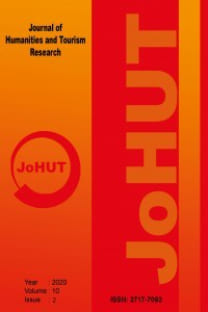The Intellectual Structure of Media Literacy Field
Media Literacy; Co-citation analysis
___
- Batagelj, V., & Mrvar, A. (1998). Pajek: A program for large network analysis. Connections. 21, 47–57. Bergsma, L. J., & Carney, M. E. (2008). Effectiveness of health-promoting media literacy education: a systematic review. Health Education Research, 23, 522 - 542. Culnan, M. J. (1987). Mapping the intellectual structure of MIS, 1980-1985: A co-citation analysis. Mis Quarterly, 11, 341-353. Dezuanni, M. (2015). The building blocks of digital media literacy: sociomaterial participation and the production of media knowledge. Journal of Curriculum Studies, 47, 416-439. Estabrooks, C. A., Derksen, L., Winther, C., Lavis, J. N., Scott, S. D., Wallin, L., & Profetto-McGrath, J. (2008). The intellectual structure and substance of the knowledge utilization field: A longitudinal author co-citation analysis, 1945 to 2004. Implementation Science,3- 49. Friesem, Y., Diane, Q. B., & Crane, E. (2014). Media Now: A Historical Review of a Media Literacy Curriculum. Journal of Media Literacy Education, 6, 35 - 55. Glanzel, W. (2003). Bibliometrics as a research field a course on theory and application of bibliometric indicators. Retrived from http://nsdl.niscair.res.in/jspui/handle/123456789/968 Goodfellow, R. (2011). Literacy, literacies and the digital in higher education. Teaching in Higher Education, 16, 131-144. Jeong, S., Cho, H., & Hwang, Y. (2012). Examining the Effects of Media Literacy Interventions: A Meta-Analysis. Journal of Communication, 62, 454–472. Jolls, T., & Wilson, C. (2014). The Core Concepts: Fundamental to Media Literacy Yesterday, Today and Tomorrow. Journal of Media Literacy Education, 6, 68 - 78. Lankshear, C., & Knobel, M. (2006). Digital literacy and digital literacies: Policy, pedagogy and research considerations for education. Digital Kompetanse, 1, 12-24. Martin, A. (2008). Digital literacy and the 'Digital Society'. In The Handbook of Research on New Literacies, edited by Colin Lankshear and Michele Knobel, 151-176. New York: Peter Lang Publishing, Inc. McCain, K. W. (1990). Mapping authors in intellectual space: A technical overview. Journal of the American society for information science, 41, 433-443. Nerur, S. P., Rasheed, A. A., & Natarajan, V. (2008). The intellectual structure of the strategic management field: An author co-citation analysis. Strategic Management Journal, 29, 319-336. doi: 10.1002/Smj.659 Persson, O., Danell, R., & Schneider, J. W. (2009). How to use Bibexcel for various types of bibliometric analysis. Celebrating scholarly communication studies: A Festschrift for Olle Persson at his 60th Birthday, 9-24. Potter, W. J. (2010). The State of Media Literacy. Journal of Broadcasting and Electronic Media, 54, 675-696. Richardson, S. M., & Paxton, S. J. (2010). An evaluation of a body image intervention based on risk factors for body dissatisfaction: A controlled study with adolescent girls. International Journal of Eating Disorders, 43, 112-122. Schvaneveldt, R. W., Durso, F. T., & Dearholt, D. W. (1989). Network structures in proximity data. The Psychology of Learning and Motivation, 24, 249-284. Small, H. (1999). Visualizing science by citation mapping. Journal of the American society for Information Science, 50, 799-813. Small, H. G., & Crane, D. (1979). Specialties and disciplines in science and social science: An examination of their structure using citation indexes. Scientometrics, 1, 445-461. White, H. D., & McCain, K. W. (1998). Visualizing a discipline: An author co-citation analysis of information science, 1972-1995. Journal of the American society for information science, 49, 327-355. William G. C. (2002). Media literacy: Moving from the margins? Journal of Broadcasting and Electronic Media, 46, 321-327. Wright, J., & Leahy, D. (2016, Forthcoming). Moving Beyond Body Image: A Sociocritical Approach to Teaching About Health and Body Size Fat Pedagogy Reader. In D. Leahy, L. Burrows, J. Wright, L. McCuaig, & D. Penny (Eds.) School Health Education in Changing Times: Curriculum, Pedagogies and Partnerships, edited by. Abingdon Oxon UK: Routledge.
- ISSN: 2717-7092
- Başlangıç: 2010
- Yayıncı: Karabük Üniversitesi
Türkiye’de Organik Ekoturizm Çiftlikleri Üzerine Bir Araştırma
XX. Yüzyılın Başında Osmanlı Devleti’nde Ekonomik Dönüşüm ve Siyasi Bloklaşma
Yerel Halkın Serbest Zaman Değerlendirme Alışkanlıkları: Safranbolu Örneği
Nuray TÜRKER, Hanife ÖLÇER, Arzuhan AYDIN
Turizmin Yerel Halkın Yaşam Kalitesi Üzerine Etkisi: Safranbolu Örneği
Nuray TÜRKER, Şengül SELÇUK, Aygül ÖZYILDIRIM
Hava Sporları Turizmi ve Safranbolu'nun Hava Sporları Potansiyelinin Belirlenmesi
Oğuz DİKER, Adnan ÇETİNKAYA, Ahmet CİNKARA
Isparta İli Turizm Potansiyelinin Değerlendirilmesine Yönelik Teorik Bir Çalışma
Balkanlar'dan Anadolu'ya Boza ve Türleri ile Türkiye’deki Balkan Kökenli Bozacılar
